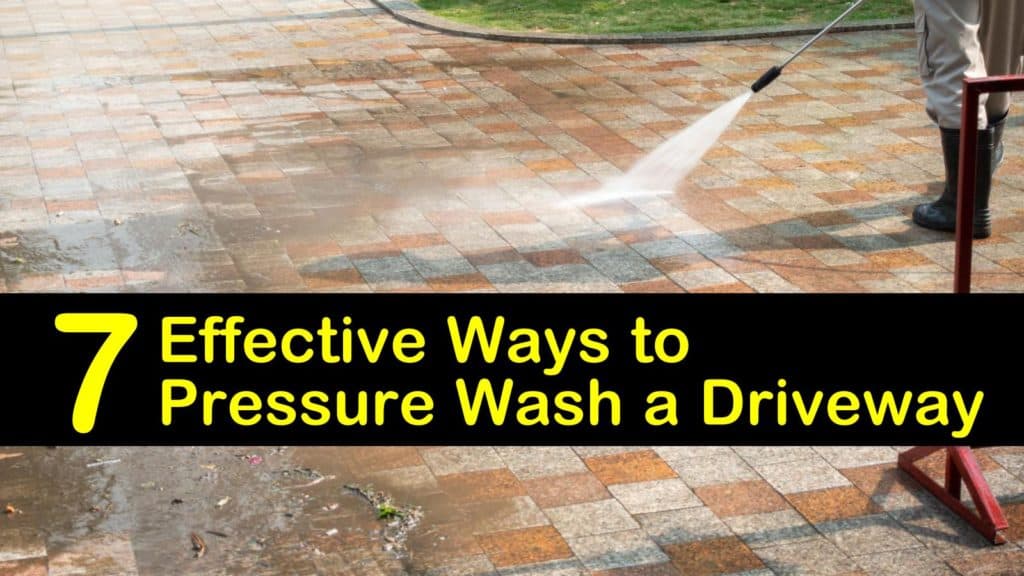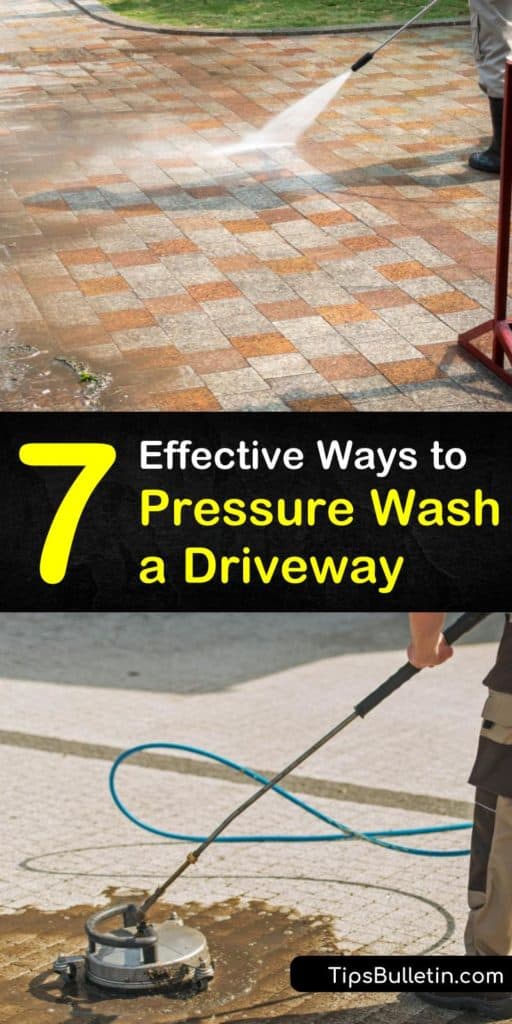As a homeowner, are you bothered by unsightly stains on your concrete driveway? Concrete stains, including oil stains, are not just an eyesore; they also weaken your driveway’s surface. Quit ignoring those stains and learn how to pressure wash a driveway to keep in ideal shape. Plus, we all know a clean driveway improves curb appeal.
Whether it’s an electric pressure washer or a gas one, both portable machines are used to clean your driveways and other concrete or brick surfaces. These pressure washers supply water through a garden hose. The engine inside the pressure washer powers the water pump, which pressurizes the water to ensure it comes out with more force than what you find with a garden hose.
How well the pressure washer cleans your driveway is determined by the gallons per minute (GPM) and the pounds per square inch (PSI). Determine how effective a power washer is by multiplying the PSI by its GPM. The higher the number, the better its cleaning ability.

Effective Ways to Pressure Wash Your Driveway
Before you grab the pressure washer to start cleaning your driveway, be warned they are designed to remove a variety of substances from the surface you are cleaning. These machines strip paint away just as quickly as they remove an oil stain. Never use high water pressure to clean bricks or pavers.
Also note that pressure washing is not the best way for removing grass from a gravel driveway. The high force of water will scatter the stones everywhere. Pour a vinegar and salt mixture on grass instead and it will dry out in a short time.
Preparation for Pressure Washing a Driveway
Before you power wash a concrete driveway, sweep away any loose dirt and debris with a broom. Once the driveway is clear of debris, work on protecting doors, walls, and windows of your home that line the driveway. Cover these with plastic sheets or some kind of tarp and secure with painters tape.
This protects the painted surfaces from peeling away if accidentally sprayed. It also provides some protection from flying debris that was missed during the initial clean up. All pressure washers are different, so before plugging yours in, read the instruction and safety manual.
These instructions provide you with all of the steps you must follow to safely and effectively use your pressure washer. You also need to determine the highest point of your driveway along with the direction the water naturally flows to aid in cleaning your driveway.

Remove Rust, Oil, and Other Stains from Concrete
When cleaning oil off driveways, use either a commercial or homemade household degreaser for best results. Some pressure washers offer an attachment tool for applying the degreaser; otherwise, use a push broom or a stiff-bristled brush to scrub the degreaser into the stain.
Sprinkle the stain directly with baking soda and allow it to sit for about five minutes. Slowly pour white vinegar directly onto the baking soda and let the ingredients fizz for several minutes. Next, apply Borax to the wet surface.
Use a stiff-bristle brush to scrub the stain and rinse degreaser away with clean water. If stain is still present, retreat with the homemade stain remover.
To remove rust stains or to remove moss from a driveway, apply undiluted lemon juice directly to the rusty spot or moss. Allow the lemon juice to sit for 15 minutes, then scrub with a stiff brush. If you don’t have lemon juice, apply undiluted white vinegar instead. Rinse away stain with cold water.
To remove mold or mildew stains from your driveway, mix a cleaner made from two parts baking soda and one part bleach. The solution appears soapy and thick when mixed correctly. Use a wire brush dipped in the cleaning solution to scrub the stains or pour the solution directly onto the stain and scrub.
Prepare your Pressure Washer for Cleaning
If your power washer came with an instruction manual, always follow those recommendations. If you bought a used one or just can’t find the instructions, here are some general guidelines to follow to prepare your pressure washer for use.
Connecting the spray wand to the washer’s hose is the first step. Once that’s done, connect the garden hose to the machine for an uninterrupted water supply. The last thing is the pressure washer nozzle; there are several to choose from based on the task at hand.
For applying soap to your driveway, opt for the low-pressure nozzle or one labeled specifically for applying detergent. Once you are ready to rinse, switch to the high-pressure nozzle for concrete, but it damages brick surfaces, so use it carefully.
How to Pressure Wash a Driveway
Pressure washing your driveway starts at the highest end. Work the washer in the same direction as the water flow as an excellent way to deep clean concrete surfaces. Hold the spray wand pointed directly at the driveway’s surface and pull the trigger.
Hold the rod at least eight inches away from the concrete, and keep the distance consistent while spraying. Use a sweeping motion across the concrete; make sure to overlap each stroke of water by about six inches. Cover the entire surface with the pressure washer cleaning solution for concrete and let it sit for 30 minutes.
Re-spray the driveway as necessary to prevent the concrete from drying out. Swap out the nozzles on your sprayer wand; the tip required to rinse your driveway is the high-pressure nozzle, also referred to as the yellow tip nozzle or the 25-degree nozzle.
Make sure you remove the siphon from the soap dispenser, so the spray wand is no longer suctioning up soap. Press the trigger and use a sweeping motion, slowly working from one side of the driveway to the other. Overlap each stroke by at least six inches and work from the top of the driveway down.
Power Washing Tips to Keep in Mind
Pressure washers increase the water pressure from your garden hose to more than 1,000 pounds per square inch. This higher pressure provides you with the ability to tackle the most stubborn stains on any concrete surface. Most homeowners find a pressure washer between 1,300 up to 2,400 psi is more than enough for driveway cleaning.
If you own a gas pressure washer for home maintenance, always keep extra gas on hand. Running out of gas while washing or rinsing your driveway is inconvenient, but you also run the risk of the concrete drying during the washing process.
Before starting your gas-powered machine, run the water for one minute, as this primes the system and removes any trapped air. Pull the start cord and allow the washer to run for one minute before you use it. Never run the machine for more than three minutes without the trigger being depressed.
For heavy stains, move the spray wand closer to the concrete surface. Move as close as four inches and make tighter sweeping motions. Slow the side to side motion to an almost standstill until the stain lifts.
Pressure washing is ideal for other applications, too. You can stain a deck without power washing but it is important to remove all large and small debris first so you have a smooth, clean surface to apply the stain.
Commercial Pressure Washer Detergent or Homemade?
Cleaning heavy duty grime from concrete requires a bit more than just high-pressure water from a power washer. To improve the cleaning power of your pressure washer, use a homemade pressure washer solution or a commercial cleaner for outstanding results.
Inside a bucket, mix the hot water with the washing soda and Borax. Stir gently until all powder dissolves. Add the liquid dish soap and stir again to combine all of the ingredients thoroughly.
To use the homemade remedy, pour into the detergent container of the pressure washer directly. Always wear safety goggles when applying concrete surface cleaner to your driveway.
This recipe also works effectively as an exterior house cleaning solution to eliminate stains and gunk that tend to accumulate on the sides of your home.
Reseal your Driveway after Pressure Washing
A pressure washer is a natural moss killer for driveways, but before you reseal your driveway, spray down a homemade moss killer to prevent future growth. You can even use the soap dispenser ability of the pressure washer to apply the moss killer before resealing.
To create the moss killer solution, mix hot water, vinegar, and salt inside a large bucket. Add a few squirts of soap to help the moss absorb the other ingredients. Never add soap in amounts of over 20% of the mixture. For preventative sprays, a few squirts work well but use more soap for killing live moss.
Use a spray bottle or pressure washer to spray the solution on your driveway and allow it to dry. Once your driveway is clean and dry, apply a concrete sealer to protect the concrete from any future stains. Use an approved concrete sealant purchased from your local home improvement store.
Pour the sealant into a plastic paint tray and use a roller attached to an extension pole to coat your driveway. Work from the top of your driveway down to the end. Start in the middle of the section and work your way out towards the edges. Allow the driveway sealant to dry for at least 24 hours before using it.

Thank you for reading about the different ways to pressure wash your driveway. If you found our tips on pressure washing a driveway useful, please share these pressure washing tips on Facebook and Pinterest so others can learn how to pressure wash a driveway correctly, too.